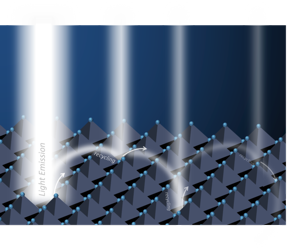Home > Press > Photon recycling The key to high-efficiency perovskite solar cells
 |
| Additional light emission is achieved by recursively recycling trapped photons in perovskites.
CREDIT Dr. Changsoon Cho |
Abstract:
Metal halide perovskites are receiving great attention as next-generation semiconductors for solar energy conversion. Since the first demonstration of 3.8% efficiency in 2009, efficiencies have increased rapidly and state-of-the-art perovskite solar cells exhibit high efficiencies over 25%, close to the record efficiencies of silicon photovoltaics. This fast growth during the last decade raises the question of whether perovskite solar cells will be able to reach the upper (thermodynamic) limit of photovoltaic efficiency, which is known to be 34% in single-junction semiconductors. To approach this goal, it is theoretically known that the solar cell must not only be a good light absorber, but also be a good light emitter.
Photon recycling The key to high-efficiency perovskite solar cells
Dresden, Germany | Posted on January 14th, 2022
The researchers from the Dresden Integrated Center for Applied Physics and Photonic Materials (IAPP) at the TU Dresden noted the role of the photon recycling effect. When a photon is radiated inside re-absorbing semiconductors such as perovskites, it can be re-absorbed by the emitter itself and generate a new photon via photoluminescence. Such a process of recursively re-absorbing and re-emitting the photons is called photon recycling. While this phenomenon has been previously demonstrated by several research groups, its practical contribution to the efficiency of perovskite solar cells has been under extensive debate. Based on the devices prepared by the groups in SNU and KU, the IAPP researchers discovered that photon recycling and light scattering effects greatly improve the light emission efficiency by a factor of ~5, significantly improving the photovoltage of perovskite solar cells.
Their work reveals the practical benefits of photon recycling in perovskite solar cells. Perovskites are already good absorbers. Now its time to improve their light-emitting ability, to even further increase their already high power conversion efficiencies, says Dr. Changsoon Cho, who led the work as a Humboldt research fellow at IAPP. Understanding photon recycling is a crucial step towards this direction. The work predicts that the contribution of photon recycling, along with the suppression of various optoelectrical losses, will lead to a further increase in performance in the future. Using photon recycling, the upper limit for the efficiency of the perovskite solar cells is shown to rise from 29.2% to 31.3%.
With the fundamental insights regarding the role of photon recycling at hand, we have a unique possibility to further enhance the perovskite solar cell efficiency, thus offering this technology ever brighter prospects to compete with the well-established silicon-based photovoltaics, adds Prof. Yana Vaynzof, Chair of Emerging Electronic Technologies at the Institute of Applied Physics and the Center for Advancing Electronics Dresden (cfaed). Indeed, the improvements in the potential of perovskite solar cells motivate to further pursue the commercialization of this technology. Our research shows the potential of the technology, but much further effort in research and development is needed before the technology can enter mass production, says Prof. Karl Leo, head of the IAPP and European Inventor Award winner.
####
For more information, please click here
Contacts:
Anne-Stephanie Vetter
Technische Universität Dresden
Office: 49-356-463-32398
Expert Contacts
Prof. Karl Leo
Dresden Integrated Center for Applied Physics and Photonic Materials (IAPP), Institute of Applied Physics, TU Dresden
Office: +49 351 463-37533
Dr. Changsoon Cho
Cavendish Laboratory, University of Cambridge
Copyright © Technische Universität Dresden
If you have a comment, please Contact us.
Issuers of news releases, not 7th Wave, Inc. or Nanotechnology Now, are solely responsible for the accuracy of the content.
News and information
![]()
NSF funds Rice effort to measure, preserve quantum entanglement: Physicist Guido Pagano wins CAREER Award to develop tools for quantum computing January 14th, 2022
![]()
Nanostructures get complex with electron equivalents: Nanoparticles of two different sizes break away from symmetrical designs January 14th, 2022
Perovskites
![]()
Templating approach stabilizes ideal material for alternative solar cells December 24th, 2021
![]()
Activating lattice oxygen in perovskite oxide to optimize fuel cell performance December 17th, 2021
![]()
Reaction-dependent coffee-ring-regulating method in spray-coating perovskite November 5th, 2021
![]()
A sunny outlook for solar: New research demonstrates great promise of all-inorganic perovskite solar cells for improving the efficiencies of solar cells October 15th, 2021
Possible Futures
![]()
UT Southwestern develops nanotherapeutic to ward off liver cancer January 14th, 2022
![]()
The free-energy principle explains the brain January 14th, 2022
Discoveries
![]()
UT Southwestern develops nanotherapeutic to ward off liver cancer January 14th, 2022
![]()
The free-energy principle explains the brain January 14th, 2022
Announcements
![]()
Nanostructures get complex with electron equivalents: Nanoparticles of two different sizes break away from symmetrical designs January 14th, 2022
![]()
UT Southwestern develops nanotherapeutic to ward off liver cancer January 14th, 2022
![]()
The free-energy principle explains the brain January 14th, 2022
Interviews/Book Reviews/Essays/Reports/Podcasts/Journals/White papers/Posters
![]()
Nanostructures get complex with electron equivalents: Nanoparticles of two different sizes break away from symmetrical designs January 14th, 2022
![]()
UT Southwestern develops nanotherapeutic to ward off liver cancer January 14th, 2022
Energy
![]()
Templating approach stabilizes ideal material for alternative solar cells December 24th, 2021
![]()
Activating lattice oxygen in perovskite oxide to optimize fuel cell performance December 17th, 2021
![]()
Nanodiamonds are key to efficient hydrogen purification: Nanodiamonds may be tiny, but they can help with one of the biggest problems facing humanity today: Climate change December 17th, 2021
![]()
Using green tea as reducing reagent for the preparation of nanomaterials to synthesize ammonia December 3rd, 2021
Solar/Photovoltaic
![]()
Templating approach stabilizes ideal material for alternative solar cells December 24th, 2021
![]()
Reaction-dependent coffee-ring-regulating method in spray-coating perovskite November 5th, 2021
![]()
A sunny outlook for solar: New research demonstrates great promise of all-inorganic perovskite solar cells for improving the efficiencies of solar cells October 15th, 2021
![]()
Ultrafast & ultrathin: new physics professor at TU Dresden makes mysterious quantum world visible September 10th, 2021










